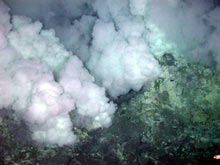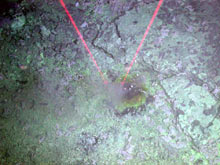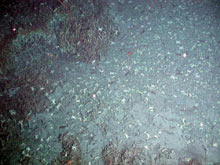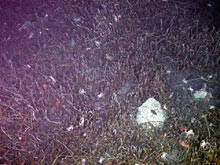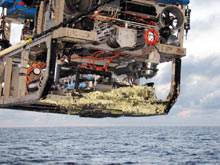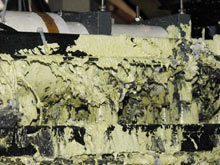These small chimneys are on the floor of Nikko caldera. The venting is so prolific that the smoke often impedes visibility on the sea floor. Click image for larger view and image credit.
A pot of molten sulfur bubbles out of the sea floor in this area of sheets of sulfur crust. The red laser beam dots are 10 cm (about 4 in) apart. Click image for larger view and image credit.
Sulfur and Water: Volcano Supports Life on Nikko Seamount
May 12, 2006
Ko-ichi Nakamura
Marine Chemist
National Institute of Advanced Science and Technology
Institute for Marine Resources and Environment — Japan
![]() The Nikko volcano has numerous hydrothermal vents, an extraordinary biomass, and marine life. (Quicktime, 1.7 Mb.)
The Nikko volcano has numerous hydrothermal vents, an extraordinary biomass, and marine life. (Quicktime, 1.7 Mb.)
![]() The crater floor at Nikko has many sulfur chimneys, both active and inactive. (Quicktime, 1.2 Mb.)
The crater floor at Nikko has many sulfur chimneys, both active and inactive. (Quicktime, 1.2 Mb.)
![]() The south rim of the summit crater at Nikko is covered by an amazing density of tubeworms. (Quicktime, 1.4 Mb.)
The south rim of the summit crater at Nikko is covered by an amazing density of tubeworms. (Quicktime, 1.4 Mb.)
![]() The south slope of the summit cone at Nikko was found to contain a large area with boiling pots of molten sulfur. (Quicktime, 1.9 Mb.)
The south slope of the summit cone at Nikko was found to contain a large area with boiling pots of molten sulfur. (Quicktime, 1.9 Mb.)
![]() Closer examination of the area around the molten sulfur pots reveals that what appears to be solid ground is really just a thin crust on a larger lake of molten sulfur! (Quicktime, 2.2 Mb.)
Closer examination of the area around the molten sulfur pots reveals that what appears to be solid ground is really just a thin crust on a larger lake of molten sulfur! (Quicktime, 2.2 Mb.)
![]() When the Jason II remotely operated vehicle tries to sample a rock, it sinks through the thin crust on a lake of molten sulfur! (Quicktime, 2 Mb.)
When the Jason II remotely operated vehicle tries to sample a rock, it sinks through the thin crust on a lake of molten sulfur! (Quicktime, 2 Mb.)
Daikoku, Eifuku, and Nikko: Where did these strange names come from? When small fishing boats became powerful enough to sail far from Japan at the beginning of the last century, brave Japanese fishermen searched for good fishing locations all over the northwestern Pacific with their small (about 10 m long!) fishing boats. When they found a productive fishing place, they code-named it and shared the locations with only the small, limited fishermen's group. Those places were later identified mostly as banks and topographic highs from hydrographic surveys. Daikoku and Eifuku are the names of the gods of wealth, and Nikko is the name of the town where the first Shogun became a god. Many other sea floor topographic names originated from secret code names of the fishermen long ago.
Each day Nikko volcano is releasing tons of sulfur, as well as carbon from a deep magma (molten rock) source, into the ocean. Sulfur is emitted from magma as gas and reacts with water in the conduit as it travels upward through the "throat" of the volcano. It forms various sulfur compounds, including elemental sulfur, hydrogen sulfide (H2S), and several types of sulfates (SO4). Microbes utilize hydrogen and sulfur to fix carbon, which in turn provides energy for other animals, either directly as symbionts within tubeworms and mussels or indirectly through predation, as in the huge populations of crabs and the flatfish found so abundantly within the summit crater of Nikko. There is so much sulfur being produced at Nikko that volcanic rocks are only rarely exposed. The sea floor in the summit crater is mostly covered by lush bushes of tubeworms in association with white crabs, flatfish, and shrimps. Hence, the volcano is "feeding" all of these animals.
Nikko is another truly amazing place on the Mariana arc and supports one of the most extensive chemosynthetic communities yet found anywhere on Earth. It will undoubtedly become a long-term study site for this and future generations of scientists.
This crab was not as lucky as Jason; it was consumed by the molten sulfur when the crust broke. "Frozen" (perhaps a bad choice of words) in time in this sulfur crust, the crab has become a valuable scientific specimen. Click image for larger view and image credit.
News Flash! Jason Returns with Unintentional “Sample” of Molten Sulfur from Nikko!
Bob Embley
Geophysicist
NOAA Vents Program, Pacific Marine Environmental Laboratory
While exploring a small crater on the south side of the summit of Nikko, Jason came across a large field of bubbling sulfur "pots." This proved to be the last of a series of most memorable discoveries made during the Submarine Ring of Fire 2006 expedition. While trying to extract a sample of the sulfur crust that covered the area, Jason inadvertently broke through the crust, and molten sulfur enveloped the lower part of the vehicle. Unfortunately, this ended the dive because of the extra weight (about 80 lbs!) suddenly added to its frame! The good news was that no damage occurred to either the vehicle or to the vent fluid sampling system that was attached to it. Several of us spent hours after the dive chipping and scraping the solidified sulfur off of the Jason chassis. The other good news is that the resulting collections of sulfur crust were valuable scientific specimens.




























